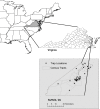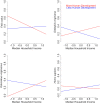Host interactions of Aedes albopictus, an invasive vector of arboviruses, in Virginia, USA
- PMID: 33600413
- PMCID: PMC7924790
- DOI: 10.1371/journal.pntd.0009173
Host interactions of Aedes albopictus, an invasive vector of arboviruses, in Virginia, USA
Abstract
Background: As an invasive mosquito species in the United States, Aedes albopictus is a potential vector of arboviruses including dengue, chikungunya, and Zika, and may also be involved in occasional transmission of other arboviruses such as West Nile, Saint Louis encephalitis, eastern equine encephalitis, and La Crosse viruses. Aedes albopictus feeds on a wide variety of vertebrate hosts, wild and domestic, as well as humans.
Methodology/principal findings: In order to investigate blood feeding patterns of Ae. albopictus, engorged specimens were collected from a variety of habitat types using the Centers for Disease Control and Prevention light traps, Biogents Sentinel 2 traps, and modified Reiter gravid traps in southeast Virginia. Sources of blood meals were determined by the analysis of mitochondrial cytochrome b gene sequences amplified in PCR assays. Our aims were to quantify degrees of Ae. albopictus interactions with vertebrate hosts as sources of blood meals, investigate arboviral infection status, assess the influence of key socioecological conditions on spatial variability in blood feeding, and investigate temporal differences in blood feeding by season. Analysis of 961 engorged specimens of Ae. albopictus sampled between 2017-2019 indicated that 96%, 4%, and less than 1% obtained blood meals from mammalian, reptilian, and avian hosts, respectively. Domestic cats were the most frequently identified (50.5%) hosts followed by Virginia opossums (17.1%), white-tailed deer (12.2%), and humans (7.3%), together representing 87.1% of all identified blood hosts. We found spatial patterns in blood feeding linked to socioecological conditions and seasonal shifts in Ae. albopictus blood feeding with implications for understanding human biting and disease risk. In Suffolk Virginia in areas of lower human development, the likelihood of human blood feeding increased as median household income increased and human blood feeding was more likely early in the season (May-June) compared to later (July-October). Screening of the head and thorax of engorged Ae. albopictus mosquitoes by cell culture and RT-PCR resulted in a single isolate of Potosi virus.
Conclusion and significance: Understanding mosquito-host interactions in nature is vital for evaluating vectorial capacity of mosquitoes. These interactions with competent reservoir hosts support transmission, maintenance, and amplification of zoonotic agents of human diseases. Results of our study in conjunction with abundance in urban/suburban settings, virus isolation from field-collected mosquitoes, and vector competence of Ae. albopictus, highlight the potential involvement of this species in the transmission of a number of arboviruses such as dengue, chikungunya, and Zika to humans. Limited interaction with avian hosts suggests that Ae. albopictus is unlikely to serve as a bridge vector of arboviruses such as West Nile and eastern equine encephalitis in the study region, but that possibility cannot be entirely ruled out.
Conflict of interest statement
The authors have declared that no competing interests exist.
Figures





Similar articles
-
Spatiotemporal distribution, abundance, and host interactions of two invasive vectors of arboviruses, Aedes albopictus and Aedes japonicus, in Pennsylvania, USA.Parasit Vectors. 2022 Jan 24;15(1):36. doi: 10.1186/s13071-022-05151-8. Parasit Vectors. 2022. PMID: 35073977 Free PMC article.
-
Comparative host feeding patterns of the Asian tiger mosquito, Aedes albopictus, in urban and suburban Northeastern USA and implications for disease transmission.PLoS Negl Trop Dis. 2014 Aug 7;8(8):e3037. doi: 10.1371/journal.pntd.0003037. eCollection 2014 Aug. PLoS Negl Trop Dis. 2014. PMID: 25101969 Free PMC article.
-
Host Associations of Culex pipiens: A Two-Year Analysis of Bloodmeal Sources and Implications for Arboviral Transmission in Southeastern Virginia.Vector Borne Zoonotic Dis. 2021 Dec;21(12):961-972. doi: 10.1089/vbz.2021.0069. Epub 2021 Oct 18. Vector Borne Zoonotic Dis. 2021. PMID: 34665047
-
An Updated Review of the Invasive Aedes albopictus in the Americas; Geographical Distribution, Host Feeding Patterns, Arbovirus Infection, and the Potential for Vertical Transmission of Dengue Virus.Insects. 2021 Oct 26;12(11):967. doi: 10.3390/insects12110967. Insects. 2021. PMID: 34821768 Free PMC article. Review.
-
Present and future arboviral threats.Antiviral Res. 2010 Feb;85(2):328-45. doi: 10.1016/j.antiviral.2009.10.008. Epub 2009 Oct 24. Antiviral Res. 2010. PMID: 19857523 Free PMC article. Review.
Cited by
-
Public health significance of the white-tailed deer (Odocoileus virginianus) and its role in the eco-epidemiology of tick- and mosquito-borne diseases in North America.Parasit Vectors. 2025 Feb 6;18(1):43. doi: 10.1186/s13071-025-06674-6. Parasit Vectors. 2025. PMID: 39915849 Free PMC article. Review.
-
Vector competence of Anopheles quadrimaculatus and Aedes albopictus for genetically distinct Jamestown Canyon virus strains circulating in the Northeast United States.Parasit Vectors. 2022 Jun 23;15(1):226. doi: 10.1186/s13071-022-05342-3. Parasit Vectors. 2022. PMID: 35739573 Free PMC article.
-
The Effects of Host Availability and Fitness on Aedes albopictus Blood Feeding Patterns in New York.Am J Trop Med Hyg. 2021 Oct 18;106(1):320-331. doi: 10.4269/ajtmh.21-0157. Am J Trop Med Hyg. 2021. PMID: 34662859 Free PMC article.
-
Impact of CHIKV Replication on the Global Proteome of Aedes albopictus Cells.Proteomes. 2022 Nov 10;10(4):38. doi: 10.3390/proteomes10040038. Proteomes. 2022. PMID: 36412637 Free PMC article.
-
Mosquitoes on a chip-environmental DNA-based detection of invasive mosquito species using high-throughput real-time PCR.PeerJ. 2024 Sep 30;12:e17782. doi: 10.7717/peerj.17782. eCollection 2024. PeerJ. 2024. PMID: 39364359 Free PMC article.
References
-
- Madon MB, Mulla MS, Shaw MW, Kluh S, Hazelrigg JE. Introduction of Aedes albopictus (Skuse) in southern California and potential for its establishment. J Vector Ecol. 2002;27: 149–154. - PubMed
-
- Hawley WA. The biology of Aedes albopictus. J Am Mosq Control Assoc Suppl. 1988;1: 1–39. - PubMed
-
- Roche B, Léger L, L’Ambert G, Lacour G, Foussadier R, Besnard G, et al.. The spread of Aedes albopictus in metropolitan France: contribution of environmental drivers and human activities and predictions for a near future. PLoS One. 2015;10: e0125600. 10.1371/journal.pone.0125600 - DOI - PMC - PubMed
Publication types
MeSH terms
Grants and funding
LinkOut - more resources
Full Text Sources
Other Literature Sources
Research Materials
Miscellaneous

